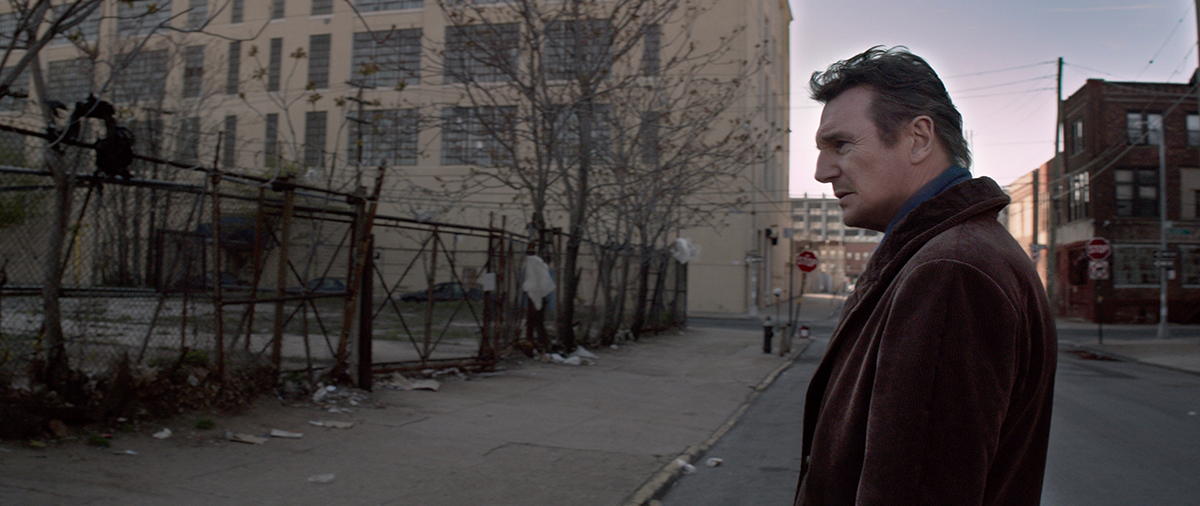
News
Pro-Palestine Encampment Represents First Major Test for Harvard President Alan Garber

News
Israeli PM Benjamin Netanyahu Condemns Antisemitism at U.S. Colleges Amid Encampment at Harvard

News
‘A Joke’: Nikole Hannah-Jones Says Harvard Should Spend More on Legacy of Slavery Initiative

News
Massachusetts ACLU Demands Harvard Reinstate PSC in Letter

News
LIVE UPDATES: Pro-Palestine Protesters Begin Encampment in Harvard Yard
A Violent 'Walk Among the Tombstones'
'A Walk Among the Tombstones'—Dir. Scott Frank (Universal Pictures)—4 Stars

The New York of 1999, which provides the setting for Scott Frank’s “A Walk Among the Tombstones,” seems pre-historic all of a sudden. Giuliani has already cleaned up the city, many people have cell phones, and the general style, from slang to shirts, is similar to the present—it’s easy to feel almost sheepish for thinking things have changed in substantive ways over the last 15 years. Almost all of it boils down to the rise of tech—the miscommunications on pay phones, microfilm searches in libraries, and even spontaneous conversations on the street that take up much of the film are so distant from a 2014 perspective. Director and writer Scott Frank portrays the increasing irrelevance of the late ’90s through constant references to Y2K, and conversations about the potential for emerging technologies to change detective work act as creation myths for the smartphone ubiquity of the present.
Frank’s highlights of impending cultural change is part of his larger portrait of a dark city populated by grim people—the film is a true neo-noir, full of sudden violence, dark alleyways, and stoicism in the face of potential death. Liam Neeson is the perfect protagonist for Frank’s world, which is based on a novel from Lawrence Block’s long-running crime series. Neeson, in some ways a relic of the ’90s himself, has perfected the gravel-voiced, aging, ruthless-yet-moral action hero over the last five years. In “A Walk Among the Tombstones,” a rare R-rated film (and, boy, is it R-rated) in his recent string of thrillers, the actor seems at his most dynamic and brutal. And unlike last spring’s “Non-Stop,” where Neeson is on his cellphone so often that director Jaume Collet-Serra superimposed his phone’s dashboard onto the screen, Neeson is entirely unencumbered and unattached. He’s a loner, a recovering alcoholic, and a private eye, and that’s about it. Neeson’s minimalist performance, in conjunction with Frank’s eerie setting, makes “A Walk Among the Tombstones” a memorable entry in the contemporary detective genre.
Neeson’s Matt Scudder is an ex-NYPD cop who quit the force after a harrowing firefight in 1991. This burst of violence opens the film—Neeson, already drinking heavily on an off-duty morning, turns to see three men rob and shoot the barkeep about 20 feet behind him. He totters up from his booth and proceeds to kill or severely maim all three of the robbers. The firefight, filled with gore and kinetic movement down the concrete stairs and alleys of NYC, both sets the tone for the hyper-realistic violence of the film and acts as a central set piece—flashbacks to the scene eventually relay further degrees of trauma than are initially clear.
Frank’s transference of the flashback as a framing device from Block’s novel adds necessary complexity to the otherwise straightforward story. In addition to Scudder’s 1991 nadir, Frank also reveals the central conflict of the story, the kidnapping of a heroin trafficker’s wife, through an elegant and horrifying flashback. The trafficker, Kenny (Dan Stevens), summons Scudder to help him find the kidnappers. Although already operating outside the law in his unlicensed detective business, Scudder initially declines to work for the drug lord. After he relays the nauseating psychosexual tactics that the kidnappers used before killing his wife anyway and packing her remains into heroin bags in the back of an abandoned car, Scudder relents.
Neeson’s decidedly pre-millennial (lots of phone books, visits to potential leads, and on-foot pursuits) detective work leads him to other murders of drug dealers’ wives and two villains (David Harbour and Eric Nelson) who are up there with Buffalo Bill from “The Silence of the Lambs” in terms of sheer depravity. Frank structures these discoveries with taut camera work—an especially shocking moment comes when a cemetery worker who knew the killers flings himself off a rooftop as soon as he tells Neeson their first names, all in one shot. For the most part, Frank keeps these scenes intricate yet minimal—the soundtrack is effective but not at all flamboyant. When he does choose to “go Scorsese” in terms of music and scale, however, it’s a welcome change—the killers’ stalking of a 14-year-old drug dealer’s daughter, which is set to “Atlantis” by Donovan, is one of the creepiest scenes in a movie full of chilling moments.
The film has few inherently likeable characters—it’s difficult not to root for Scudder and the drug dealers whose loved ones he tries to save, but there’s always the lingering feeling that all the characters have made their own beds. The exception is T.J. (Brian “Astro” Bradley), a homeless kid who Neeson hires as an assistant. Somehow, this subplot, which could easily be maudlin and even offensive, helps provide an entirely sympathetic character. “A Walk Among the Tombstones” doesn’t provide any genre innovations, but its grit, sophisticated storytelling, and ambiance of the past are exhilarating.
—Staff writer David J. Kurlander can be reached at david.kurlander@thecrimson.com.
Want to keep up with breaking news? Subscribe to our email newsletter.
